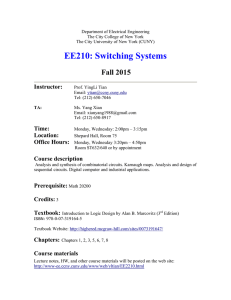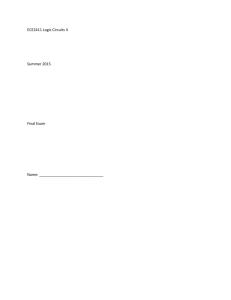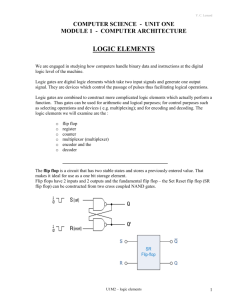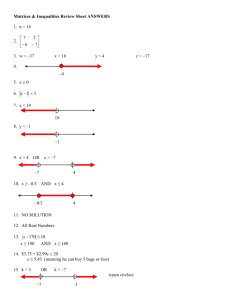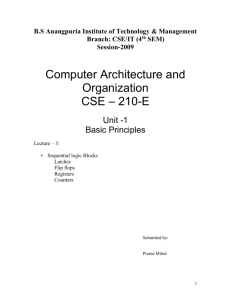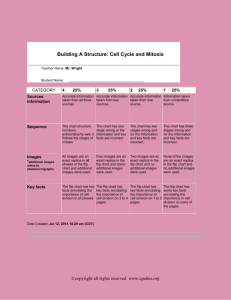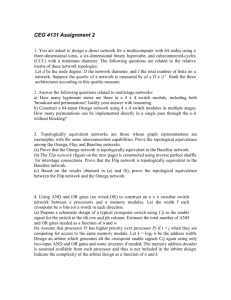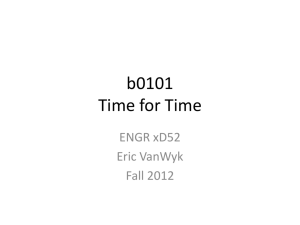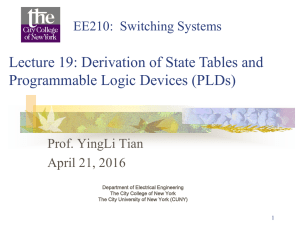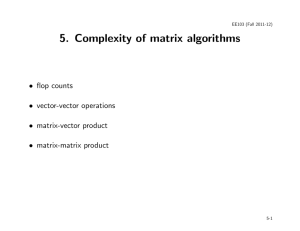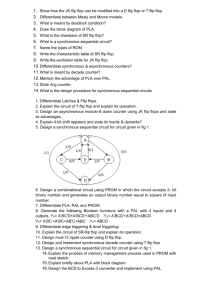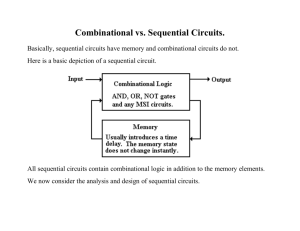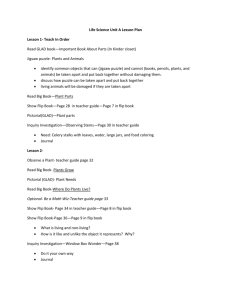Final_Exam_I_Solution
advertisement
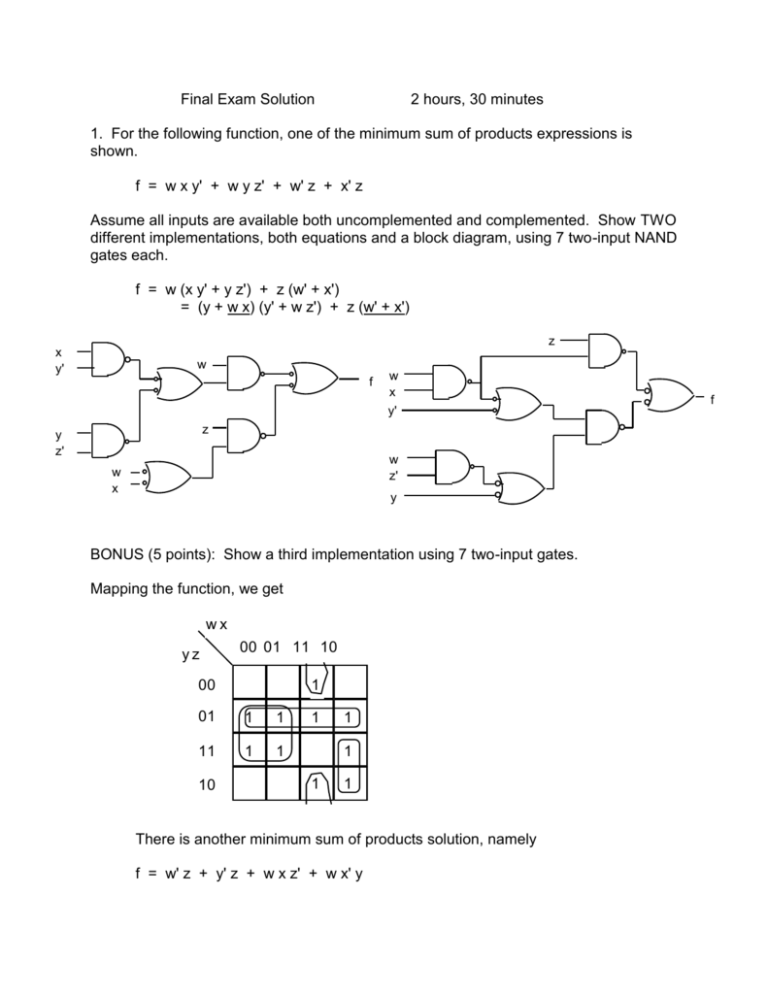
Final Exam Solution
2 hours, 30 minutes
1. For the following function, one of the minimum sum of products expressions is
shown.
f = w x y' + w y z' + w' z + x' z
Assume all inputs are available both uncomplemented and complemented. Show TWO
different implementations, both equations and a block diagram, using 7 two-input NAND
gates each.
f = w (x y' + y z') + z (w' + x')
= (y + w x) (y' + w z') + z (w' + x')
z
x
y'
w
f
w
x
y'
z
y
z'
w
z'
w
x
y
BONUS (5 points): Show a third implementation using 7 two-input gates.
Mapping the function, we get
wx
yz
00 01 11 10
00
1
01
1
1
11
1
1
10
1
1
1
1
1
There is another minimum sum of products solution, namely
f = w' z + y' z + w x z' + w x' y
f
This yields two more solutions like those above
f = z (w' + y') + w (x z' + x' )
= (x + w y) (x' + w z') + z (w' + y')
2. For the three functions shown, find the equations for a minimum two-level AND-OR
solution. (Minimum is 8 gates/24 gate inputs) You must circle the terms on the maps
and write the equations. Show the sharing in the equations. (A block diagram is NOT
required.)
ab
cd
ab
00 01 11 10
1
00
01
cd
1
1
1
f
1
cd
1
00
01
11
10
ab
00 01 11 10
1
1
00 01 11 10
00
1
1
01
1
1
11
1
1
11
1
1
10
1
1
10
1
1
g
f = b c' d + a b' c’ d' + a c d'
g = a b' c’ d' + b c' d + a' c
h = a' c + a b' c’ d' + b c' + a c d'
1
h
1
1
3. For the following 5-variable function, find as many minimum sum of products
expressions as you can. (Full credit for 4 expressions, each with 6 terms and 18
literals.) (Three copies of the maps are there if you need them.) 3 points BONUS for
each additional solution.
A
0
1
BC
BC
00 01 11 10
00 01 11 10
DE
DE
00
1
01
1
11
10
X
00
X
1
1
X
01
X
1
11
X
10
1
1
X
X
1
1
1
1
1
F = A' C E + A C' E' + A B D' + B' C D + B' D' E + {B' C' E' or B' C' D'}
BC
DE
0
00 01 11 10
00
1
01
1
11
10
X
A
BC
DE
00
X
1
1
X
01
X
1
11
X
1
00 01 11 10
10
1
1
X
X
1
1
1
1
1
F = A' C E + A C' E' + A B D' + B' C D + B' C' D' + {B' C E or C D' E or A D' E}
BC
DE
0
00 01 11 10
00
1
01
1
11
10
X
A
BC
DE
00
X
1
1
X
01
X
1
11
X
1
00 01 11 10
10
1
1
X
X
1
1
1
1
1
F = A' C E + A C' E' + A B D' + B' C E + B' C' D' + B' D E'
4. a) For the following function, f, find the minimum sum of products expression.
ab
00 01 11 10
cd
00
1
1
1
01
1
1
11
1
1
10
1
1
1
f = a' b + b d + b' c' d' + a b' d
b) For the following function, g, find BOTH the minimum sum of products expression
and the minimum product of sums expression. (Blank map shown for your
convenience.)
wx
yz
wx
00 01 11 10
00
1
1
01
1
1
01
11
1
11
10
1
10
g = w' x + w' y' + x y' z'
1
yz
00 01 11 10
1
00
1
1
1
1
1
1
1
1
g' = x' y + w x' + w z + w y
g = (x + y') (w' + x) (w' + z') (w' + y')
5. Consider the following state table:
q
A
B
C
D
E
q *
x=0
A
A
E
E
A
z
x=1
D
C
B
B
D
0
0
1
0
0
The list of the smallest non-trivial partitions putting two states in the same block is
P1 = (A B) (C D) (E)
P2 = (A E) (B) (C) (D)
P3 = (A E) (B C) (D)
P4 = (A E) (B C D)
P5 = (A) (B E) (C D)
P6 = (A) (B) (C D) (E)
a) Find the other two non-trivial SP partitions.
P7 = P1 + P2 = (A B E) (C D)
P8 = P2 + P6 = (A E) (B) (C D)
b) Reduce this to the minimum number of states. Show the reduced state table.
q
A
B
C
D
q *
x=0
A
A
A
A
z
x=1
D
C
B
B
0
0
1
0
c) Show the non-trivial SP partitions for the reduced system.
P3* = (A E) (B C) (D)
P4* = (A E) (B C D)
P7* = (A B E) (C D)
P8* = (A E) (B) (C D)
6. Show a state table or a state diagram for a Mealy system with one input, x, and one
output, z, such that z = 1 if and only if the input has been exactly two 1's followed
immediately by exactly two 0's followed by exactly one 1.
(Full credit for a system with 7 states.)
Example
x
z
0 1 1 0 0 1 0 1 1 0 0 0 1 0 1 1 0 0 1 1 0
0 0 0 0 0 0 1 0 0 0 0 0 0 0 0 0 0 0 0 0 0 0
0/0
A
0/1
0/0
1/0
0/0
0/0
G
1/0
B
D
1/0
1/0
F
1/0
0/0
1/0
E
0/0
C
1/0
7. For the following circuit, complete the timing diagram below (for A, B, and z).
PRE'
z
x
D
A
J
B
A'
K
B'
CLOCK
CLR'
D = xB
CLOCK
CLR'
PRE'
x
A
B
z
B* = A'
z = A' + B'
8. For the following state table, show a state diagram and complete the timing trace as
far as you can.
q
q *
x=0
A
A
E
E
A
A
B
C
D
E
x
q
z
0
A
0
z
x=1
D
C
B
B
D
0
0
1
0
1
1 1 1 0 1 1 0
A D B C E D B A
0 0 0 1 1 0 0 0 0
9. For the following state table
q
q*
x=0
D
B
B
A
A
B
C
D
x=1
C
A
D
B
z
1
1
0
0
Design the system using JK flip flops for each of the two state assignments. You need
only show the equations for J, K and z.
a)
A
B
C
D
A
q
A
B
C
D
x
0
0
0
0
1
q1
0
0
1
1
0
q1
0
0
1
1
q2
0
1
0
1
0
q2
0
1
0
1
q1*
1
0
0
0
1
q2*
1
1
1
0
0
b)
q
A
B
C
D
A
B
D
C
A
x
0
0
0
0
1
q1
0
0
1
1
q1
0
0
1
1
0
q2
0
1
0
1
0
q2
0
1
1
0
q1*
1
0
0
0
1
q2*
0
1
0
1
1
B
C
D
1
1
1
0
1
1
1
0
1
0
1
0
0
1
1
B
D
C
a)
1
1
1
0
1
1
1
0
1
0
0
1
0
1
0
b)
x
0
q 1q 2
1
q q
1
00
x
x
0
1
2
q 1q 2
00
1
00
01
01
1
01
11
11
10
1
1
1
q 1*
1
10
q *
1
11
1
10
x
0
1
q 1q 2
1
1
00
1
J1 = q2'
J2 = x' + q1
K1 = x' + q2 K2 = x' q1' + x q1
1
1
01
1
11
1
1
10
q 1*
2
0
q *
2
J1 = q2'
J2 = x
K1 = x' + q2' K2 = x
10. For the following state table
q1 q2
00
01
11
q1*q2*
x=0
x=1
11
01
00
11
11
01
z
0
1
0
Design the system using a T flip flop for q1 and an SR flip flop for q2. Just show the
equations for the flip flop inputs and the output.
x
q1
0
0
0
0
0
1
0
1
1
0
1
0
1
1
1
1
Mapping these, we get
q2
0
1
0
1
0
1
0
1
q1*
1
0
X
1
0
1
X
0
q2*
1
0
X
1
1
1
X
1
T1
1
0
X
0
0
1
X
1
S2
1
0
X
X
1
X
X
X
R2
0
1
X
0
0
0
X
0
T1 = x' q2' + x q2
S2 = q2'
R2 = x' q1' q2
z = q1' q2
11. Design a counter with two flip flops and one input using D flip flops that goes
through the cycle for
x = 0: 0 1 2 3 and repeat
x = 1: 1 2 3 3 (and remaining there)
Just show the input equations for the two flip flops. There is no output other than the
state of the flip flops.
x
0
0
0
0
1
1
1
1
q1
0
0
1
1
0
0
1
1
q2
0
1
0
1
0
1
0
1
q1*
0
1
1
0
X
1
1
1
q2*
1
0
1
0
X
0
1
1
D1 = q1* = x + q1' q2 + q1 q2'
D2 = q2* = x q1 + q2'
BONUS: Show a state diagram, including what happens if x goes to 1 when the
counter is in state 0. (Each path is labeled with just the inputs.)
Using x = 1, q1 = 0 and q2 = 0, we get q1* = 1 and q2* = 1
0
0
0
1
3
1
X
X
2
1
